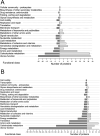The Azotobacter vinelandii AlgU regulon during vegetative growth and encysting conditions: A proteomic approach
- PMID: 37967103
- PMCID: PMC10651043
- DOI: 10.1371/journal.pone.0286440
The Azotobacter vinelandii AlgU regulon during vegetative growth and encysting conditions: A proteomic approach
Abstract
In the Pseduomonadacea family, the extracytoplasmic function sigma factor AlgU is crucial to withstand adverse conditions. Azotobacter vinelandii, a closed relative of Pseudomonas aeruginosa, has been a model for cellular differentiation in Gram-negative bacteria since it forms desiccation-resistant cysts. Previous work demonstrated the essential role of AlgU to withstand oxidative stress and on A. vinelandii differentiation, particularly for the positive control of alginate production. In this study, the AlgU regulon was dissected by a proteomic approach under vegetative growing conditions and upon encystment induction. Our results revealed several molecular targets that explained the requirement of this sigma factor during oxidative stress and extended its role in alginate production. Furthermore, we demonstrate that AlgU was necessary to produce alkyl resorcinols, a type of aromatic lipids that conform the cell membrane of the differentiated cell. AlgU was also found to positively regulate stress resistance proteins such as OsmC, LEA-1, or proteins involved in trehalose synthesis. A position-specific scoring-matrix (PSSM) was generated based on the consensus sequence recognized by AlgU in P. aeruginosa, which allowed the identification of direct AlgU targets in the A. vinelandii genome. This work further expands our knowledge about the function of the ECF sigma factor AlgU in A. vinelandii and contributes to explains its key regulatory role under adverse conditions.
Copyright: © 2023 Chowdhury-Paul et al. This is an open access article distributed under the terms of the Creative Commons Attribution License, which permits unrestricted use, distribution, and reproduction in any medium, provided the original author and source are credited.
Conflict of interest statement
The authors have declared that no competing interests exist.
Figures




References
-
- Kennedy, C., Rudnick, P, MacDonald M L, Melton T. Genus III Azotobacter. A. I. B. D. 1901, Noel NK, Staley JT, Garryty GM. Bergey´s Manual of systematic Bacteriology. A. I. B. D. 1901, Noel NK, Staley JT, Garryty GM. New York, NY: Springer; 2005. pp. 384–402.
-
- Segura D, Núñez C, Espín G. Azotobacter Cysts. In: Wiley John & Ltd Sons, editor. eLS. Chichester, UK: John Wiley & Sons, Ltd; 2020. p. a0000295.pub2. doi: 10.1002/9780470015902.a0000295.pub3 - DOI
Publication types
MeSH terms
Substances
LinkOut - more resources
Full Text Sources
Molecular Biology Databases

